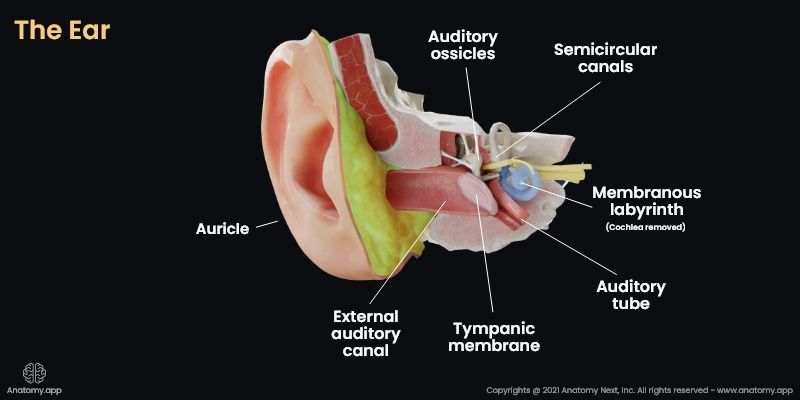- Anatomical terminology
- Skeletal system
- Joints
- Muscles
- Heart
- Blood vessels
- Nervous system
- Respiratory system
- Digestive system
- Lymphatic system
- Female reproductive system
- Male reproductive system
- Endocrine glands
- Eye
- Ear
Semicircular canals
The semicircular canals are three bony canals within the internal ear situated behind the vestibule and arranged in three mutually perpendicular planes. Each canal makes a 90-degree angle with the other canal. Within every semicircular canal is the corresponding semicircular ducts of the membranous labyrinth.

Structure of semicircular canals
The semicircular canals of the bony labyrinth contain perilymphatic fluid and the membranous semicircular ducts. Each semicircular canal has two limbs - ampullar crus and simple crus, while the common crus is shared between the anterior and posterior semicircular canals. The ampullar crus is dilated, while the rest of the canal is narrow.
The superior and posterior semicircular canals are vertical at right angles to each other, while the lateral canal is 30-degrees from the horizontal plane. These different orientations mean that different canals will be stimulated by the movement of the head in different planes. If the movement occurs outside these planes, more than one canal is activated.
Each semicircular canal of the bony labyrinth is filled with perilymph and encloses the corresponding semicircular duct of the membranous labyrinth, which is filled with endolymph.
Anterior semicircular canal
The anterior semicircular canal (Latin: canalis semicircularis anterior) is oriented vertically and somewhat perpendicular to the axis of the petrous part of the temporal bone and positioned in the sagittal plane. It shares a common crus with the posterior semicircular canal. The anterior semicircular canal detects rotations of the head around the lateral axis, for example, nodding the head. The canal is approximately 15-20 mm long.
Posterior semicircular canal
The posterior semicircular canal (Latin: canalis semicircularis posterior) is the posterior and most inferior semicircular canal that is oriented somewhat vertically and parallel to the longitudinal axis of the petrous part of the temporal bone. The posterior semicircular canal detects rotation of the head around the anteroposterior axis, for example, if trying to touch the shoulder with the head or being on a cartwheel.
It shares a common crus with the anterior semicircular canal. The canal is directed superiorly and posteriorly. On the medial side of the canal is the vestibular aqueduct. The posterior semicircular canal is the longest of all canals, around 18 to 22 mm long.
Lateral semicircular canal
The lateral semicircular canal (Latin: canalis semicircularis lateralis) is oriented horizontally and sometimes creates a bulge in the medial wall of the tympanic cavity. The lateral semicircular canal is the shortest canal, only 12 to 15 mm long. The fluid moves within the canal when the head is rotated around the vertical axis, for example, when turning the head from side to side. its ampullar crus end corresponds to the upper and lateral angle of the vestibule, close to the superior canal's ampullar crus.